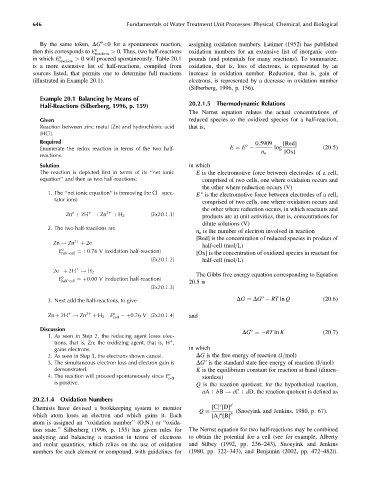Page 691 - Fundamentals of Water Treatment Unit Processes : Physical, Chemical, and Biological
P. 691
646 Fundamentals of Water Treatment Unit Processes: Physical, Chemical, and Biological
o
By the same token, DG <0 for a spontaneous reaction, assigning oxidation numbers. Latimer (1952) has published
o
then this corresponds to E reaction > 0. Thus, two half-reactions oxidation numbers for an extensive list of inorganic com-
o
in which E reaction > 0 will proceed spontaneously. Table 20.1 pounds (and potentials for many reactions). To summarize,
is a more extensive list of half-reactions, compiled from oxidation, that is, loss of electrons, is represented by an
sources listed, that permits one to determine full reactions increase in oxidation number. Reduction, that is, gain of
(illustrated in Example 20.1). electrons, is represented by a decrease in oxidation number
(Silberberg, 1996, p. 156).
Example 20.1 Balancing by Means of
20.2.1.5 Thermodynamic Relations
Half-Reactions (Silberberg, 1996, p. 159)
The Nernst equation relates the actual concentrations of
Given reduced species to the oxidized species for a half-reaction,
Reaction between zinc metal (Zn) and hydrochloric acid that is,
(HCl).
Required 0:5909 [Red]
o
Enumerate the redox reaction in terms of the two half- E ¼ E log (20:5)
n e [Ox]
reactions.
Solution in which
The reaction is depicted first in terms of its ‘‘net ionic E is the electromotive force between electrodes of a cell,
equation’’ and then as two half-reactions: comprised of two cells, one where oxidation occurs and
the other where reduction occurs (V)
1. The ‘‘net ionic equation’’ is (removing the Cl spec- E 8 is the electromotive force between electrodes of a cell,
tator ions)
comprised of two cells, one where oxidation occurs and
the other where reduction occurs, in which reactants and
o
Zn þ 2H ! Zn 2þ þ H 2 (Ex20:1:1)
þ
products are at unit activities, that is, concentrations for
dilute solutions (V)
2. The two half-reactions are
n e is the number of electron involved in reaction
[Red] is the concentration of reduced species in product of
Zn ! Zn 2þ þ 2e
half-cell (mol=L)
E o half-cell ¼þ0:76 V (oxidation half-reaction) [Ox] is the concentration of oxidized species in reactant for
(Ex20:1:2) half-cell (mol=L)
2e þ 2H ! H 2
þ
The Gibbs free energy equation corresponding to Equation
E o ¼þ0:00 V (reduction half-reaction)
half-cell 20.5 is
(Ex20:1:3)
o
3. Next add the half-reactions, to give DG ¼ DG RT ln Q (20:6)
Zn þ 2H ! Zn 2þ þ H 2 E o cell ¼þ0:76 V (Ex20:1:4) and
þ
Discussion DG ¼ RT ln K (20:7)
o
1. As seen in Step 2, the reducing agent loses elec-
trons, that is, Zn; the oxidizing agent, that is, H ,
þ
gains electrons. in which
2. As seen in Step 3, the electrons shown cancel. DG is the free energy of reaction (J=mol)
o
3. The simultaneous electron loss and electron gain is DG is the standard state free energy of reaction (J=mol)
demonstrated. K is the equilibrium constant for reaction at hand (dimen-
4. The reaction will proceed spontaneously since E o
cell sionless)
is positive. Q is the reaction quotient; for the hypothetical reaction,
aA þ bB ! cC þ dD, the reaction quotient is defined as
20.2.1.4 Oxidation Numbers
c
Chemists have devised a bookkeeping system to monitor [C] [D] d
Q a b (Snoeyink and Jenkins, 1980, p: 67):
which atom loses an electron and which gains it. Each [A] [B]
atom is assigned an ‘‘oxidation number’’ (O.N.) or ‘‘oxida-
tion state.’’ Silberberg (1996, p. 155) has given rules for The Nernst equation for two half-reactions may be combined
analyzing and balancing a reaction in terms of electrons to obtain the potential for a cell (see for example, Alberty
and molar quantities, which relies on the use of oxidation and Silbey (1992, pp. 236–243), Snoeyink and Jenkins
numbers for each element or compound, with guidelines for (1980, pp. 322–343), and Benjamin (2002, pp. 472–482)).

